Type Light rail transit Stations 36 & 2 reserve Locale Klang Valley Owner Prasarana Malaysia | Status Operational Electrification Third rail Operator Rapid Rail | |
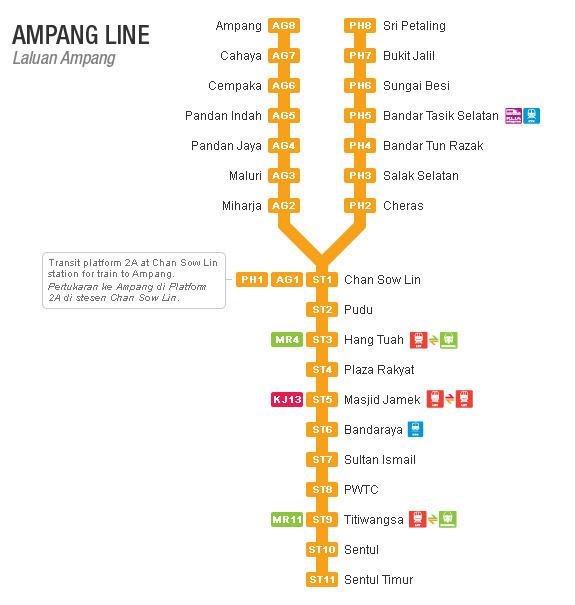 | ||
Native name LRT Laluan Ampang & LRT Laluan Sri Petaling System LRT KL System 1 (LRT1) - SelTrac CBTC Termini Start: Sentul TimurEnd:Putra Heights & Ampang | ||
New lrt ampang line train video walkthrough malaysia public transport
The LRT Ampang Line and LRT Sri Petaling Line are the third and fourth rail transit lines and the first semi automated rail system in the Klang Valley area. They are a part of the Greater KL/Klang Valley Integrated Transit System, under the Land Public Transport Commission of Malaysia (SPAD). The lines are numbered 3 and 4 and coloured orange & maroon respectively on the official transit map. The entire network is the first standard gauge rail transit system in Malaysia that commenced its service in 1996.
Contents
- New lrt ampang line train video walkthrough malaysia public transport
- New lrt ampang line train 4k
- Stations
- LRT Sri Petaling Line stations
- LRT Ampang Line stations
- LRT1 Extension Project
- Interchanges
- Rolling stock
- History
- Accidents
- References

Prior to July 2016, both rail transit lines were collectively known as Ampang Line. On 17 July 2016, following the completion of the extension of Sri Petaling Line towards Putra Heights, Prasarana Malaysia introduced the service from Ampang to Chan Sow Lin and Putra Heights to Sentul Timur, but on 1 December the Ampang line was a direct service to Sentul Timur. Prasarana Malaysia has introduced two new modes of operation via its operator subsidiary, Rapid Rail. The LRT system is currently distinguished into two main lines namely:
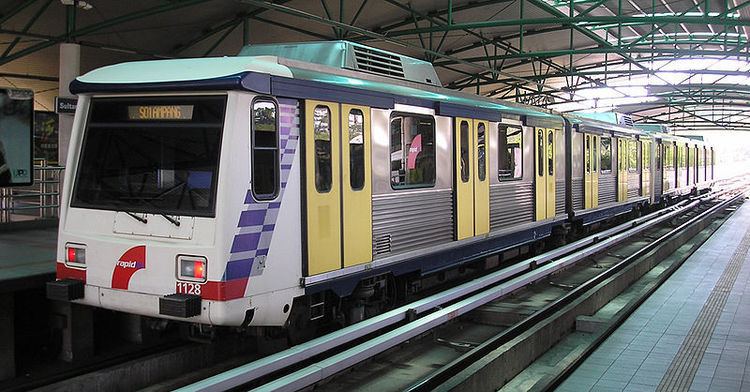
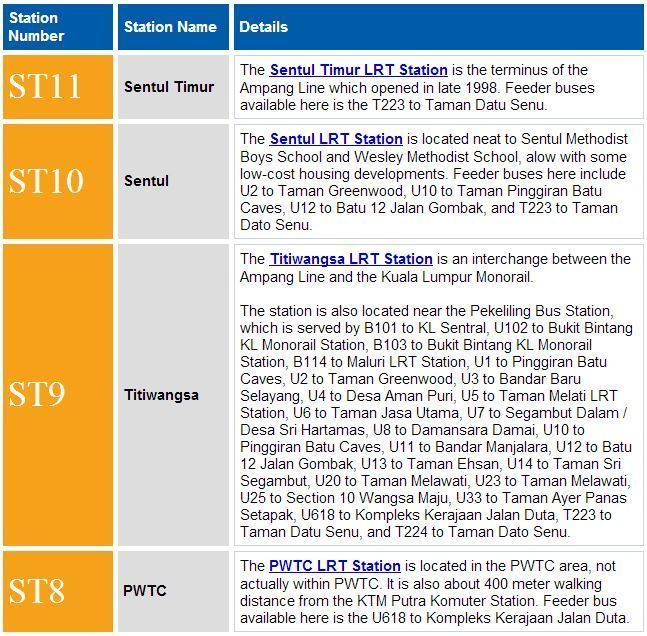
These rail transit lines share a similar train system at Ampang Operational and Control Centre with different depots located at Ampang and Kampung Kuala Sungai Baru at Putra Heights.
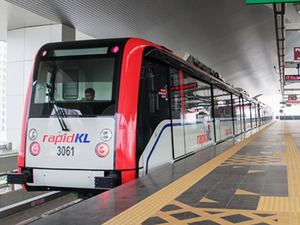
New lrt ampang line train 4k
Stations

The Ampang Line system network consists of two main service lines with a total length of 34.4 kilometres that begin at two different stations to the south and east of the city, meeting at an interchange station, continuing through the city centre and ending at the same station at the north. The LRT Ampang Line begins at Ampang, while the LRT Sri Petaling Line currently begins at Putra Heights . Both lines converge at Chan Sow Lin; the line leads to the north, both terminating at Sentul Timur. The Ampang to Sultan Ismail section was the first phase of the LRT system to open, on 16 December 1995, with the second stretch from Chan Sow Lin to Sri Petaling operational on 11 July 1998, primarily for accessibility to the National Sports Complex during the 1998 Commonwealth Games via the Bukit Jalil station. The section between Sultan Ismail and Sentul Timur opened on 6 December 1998.The passenger seating capacity is 168 seats per train (without wheelchair).

The route between Plaza Rakyat and Sentul Timur is an elevated railway, running along the Gombak River between Bandaraya and Titiwangsa. The Chan Sow Lin-Ampang route is primarily at surface level, using a previously disused railway formation, while the Chan Sow Lin-Plaza Rakyat route and the Sri Petaling-Chan Sow Lin route use a combination of surface-level and elevated tracks. There are no underground sections.

The system network includes 29 stations: eleven along the Sentul Timur as a common stations, and seven each along the LRT Ampang Line and the LRT Sri Petaling Line. The service depot and primary train depot is currently at Ampang. There is a temporary secondary train depot at Sri Petaling station. New depot at Kuala Sungai Baru has been build to support Ampang depot due to limited area for development and to cater new CSR Zhuzhou train.
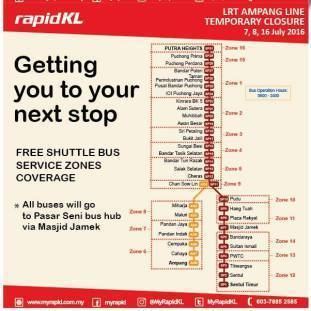
Unlike previous railway system in Malaysia, which were built to metre gauge, the Ampang Line network system was the first railway system in the country to adopt standard gauge. Between Ampang and Plaza Rakyat and between Chan Sow Lin and Salak Selatan, the line uses the trackbed of previously disused lines that were part of the Malayan Railway network (Ampang/Sultan Street branch), closed in the 1960s (between the present Chan Sow Lin station and the present Plaza Rakyat) and the early 1990s (the remaining portion of the line). The Ampang depot stands on the site of the former Ampang railway station.
Ridership on the line has been far below expectations. Built with a capacity of 500,000 passengers per day and a breakeven point of 170,000 passengers per day, in 1998, two years after launch, the line was averaging only 53,000 passengers per day, in part because of fares perceived as too high. In 2002, STAR-LRT was taken over by the government-owned Syarikat Prasarana Negara Berhad. By 2003, the ridership had increased to 110,000, still insufficient for profitability.
LRT Sri Petaling Line stations
Chan Sow Lin is the interchange station between the two routes. The route that runs to Ampang station consists of seven stations running into East of Klang Valley. Passengers to Sri Petaling should disembark at Chan Sow Lin station. But on July 17, 2016, commuters no longer have to switch trains to Putra Heights, instead, they have to switch trains if they wishes to go to Ampang. Passengers will also have to disembark at Chown Sow Lin from Sentul Timur to continue their journey to Ampang.
On 29 August 2006, Deputy Prime Minister Mohd Najib Abdul Razak announced that the southern end of the LRT Sri Petaling Line would be extended from its existing terminus at Sri Petaling station to the suburbs of Puchong and Putra Heights, south-west of Kuala Lumpur. The first phase of the line extension work, a 7.4 km four-station phase from Sri Petaling to Bandar Kinrara (with four new stations: Awan Besar, Muhibbah, Alam Sutera and Kinrara BK5) opened on 31 October 2015 and IOI Puchong Jaya, Pusat Bandar Puchong, Taman Perindustrian Puchong and Bandar Puteri opened on 28 March 2016. Full service for the remaining stations to Putra Heights started on 30 June 2016.
LRT Ampang Line stations
Chan Sow Lin is an interchange station between the two lines. The line that runs to Ampang station consists of seven stations running into East of Klang Valley. From 17 July 2016 to 30 November 2016, passengers to Ampang were required to disembark and switch trains at Chan Sow Lin station, as the main line only served the trains from Sentul Timur to Putra Heights while signalling system upgrades were taking place.
Beginning from 1 December 2016, the new six-car AMY trains finally served the direct service from Ampang to Sentul Timur. This is possible due to the upgrading of the signalling system (Communication-Based Train Control), for the entire Ampang and Sri Petaling Line.
LRT1 Extension Project
On 29 August 2006, Malaysian Deputy Prime Minister Mohd Najib Abdul Razak announced that the southern end of the Sri Petaling Line, which now ended at Sri Petaling station, would be extended to the suburbs of Puchong and Putra Heights, located to the south-west of Kuala Lumpur. The extension will be part of a 10bil ringgit plan to expand Kuala Lumpur's public transport network.
In September 2009, Syarikat Prasarana Negara began a public viewing for the details of the alignment for the Ampang Line and Kelana Jaya Line at various locations. After a number of amendments and public viewings, the new LRT extension will add 11 new stations and 18.1 km of new track. The Ampang Line Extension Project starts from Sri Petaling Station and passes through Kinrara, Puchong and ends at the new terminus of Putra Heights where the line will meet the Kelana Jaya Line to provide a suburban interchange. Construction works on the Kelana Jaya Line Extension Project and the Ampang Line Extension Project escalated at the end of March 2011, with commencement of structural works, subject to approval from state government and local authorities. Thales Group were selected to provide SelTrac Communications-Based Train Control (CBTC) for the extension.
The first phase of the line extension work, a 7.4 km four-station phase from Sri Petaling to Bandar Kinrara (with four new stations: Awan Besar, Muhibbah, Alam Sutera and Kinrara BK5) opened on 31 October 2015, while the full service on the remaining stations to Putra Heights was commenced on 30 June 2016. The extension project is slated to double the ridership on the Ampang Line system network to more than 400,000 passengers per day.
Interchanges
When the STAR-LRT, current name is Ampang Line system network was launched in 1996, the Bandaraya LRT station became the first LRT station to be designated as an interchange station, with a footbridge connecting to the Bank Negara Komuter station, a commuter rail station of Seremban Line & Port Klang Line, a few hundred metres away. With the completion of the Sri Petaling-Chan Sow Lin route, the Bandar Tasik Selatan station was opened as another integrated interchange station for the Seremban Line service and KLIA Transit. The line includes interconnectivity with Kelana Jaya Line, KLIA Transit, KL Monorail services, Sungai Buloh-Kajang MRT Line & Sungai Buloh-Serdang-Putrajaya Line service in the future. With the extension from Sri Petaling LRT station to Putra Heights LRT station, there will be an interchange at the Putra Heights station with Kelana Jaya Line, along with the current Masjid Jamek LRT station on the main line. The system currently has a total of six stations linked to other railway systems.
The Ampang Line system network is the only rail system in the Kuala Lumpur that, though it passes through the city centre, does not stop within or near Kuala Lumpur Sentral. This is because KL Sentral, despite its name, is not in fact in the centre of KL.
Rolling stock
The rolling stock of the Ampang Line currently consists of a fleet of 90 Adtranz standard-gauge light rail vehicle (LRV) manufactured by Walkers Limited of Australia. These trains are electric multiple units (EMU), which draw power from the underside of a third rail alongside the track. All cars in each train are powered. The trains are manned, with driver cabs occupying the ends of the train.
The trainsets come in two configurations. The first and most common variation is the six-car trainset, which consists of three sets of two EMUs (2+2+2) and occupies the maximum platform length of the stations. Each of the two EMU sets at the front and rear consist of one driving car and one trailer car, while the two EMUs between are trailer cars. Each two EMU sets are not connected to other EMU sets in the train. The second variation is a four-car trainset, a more obscure configuration that consists of only two EMU sets (2+2) of one driving car and one trailer car at both ends. These are only two-thirds the length and number of cars of the six-car variation. The 2+2 trainsets were used in full service until the widespread deployment of 2+2+2 trainsets.
Each car has 3 bogies: 2 power bogies and one articulated trailer for the centre bogie. The end cars, numbered 1101 to 1260, have driver cabs. Middle cars numbered 2201 to 2230 have a concealed driver control panel, enabling the car to be moved around the depot independently.
The train interiors are simple and basic. There are no individual seats, only longitudinal bench seating on either side of the train, surfaced in metal, while spaces near the connecting ends of the cars are provided for passengers who use wheelchairs and other assistive devices. There is a large amount of floorspace for standing passengers. The rolling stock has remained relatively unchanged since its introduction in 1996; new trains will be used on the line from October 2015.
50 new trains will be deployed to increase the capacity of the line and provide a better service. Each of the new trains is six cars long and provided by CSR Zhuzhou of China, similar to on the design for İzmir Metro and Buenos Aires Underground 200 Series. These trains are disabled-friendly and include safety features like closed-circuit TV, emergency breakable window, emergency ventilation fan, fire and smoke detection system and supervised automatic train operation system (SATO), and other elements such as interactive destination display inside the train, non-slipping seats, LCD infotainment, walk-through gangways, and a more spacious wheelchair space for the physically challenged.
The Ampang Line system network fleet consisted of the following models:
History
The system has assumed multiple names throughout its service. Initially known as STAR (Malay: Sistem Transit Aliran Ringan; English: Light Rail Transit System), the STAR LRT or the STAR Line, the system was renamed in 2005 to refer to system's two service routes: the LRT Sri Petaling Line and LRT Ampang Line. In April 2007, the entire LRT system was renamed the Ampang Line system network as one common line, with no official names given to the service route. With refer to the new opening stations at Ampang Line Extension Project, the service route has been rename again to distinguish its own route.
